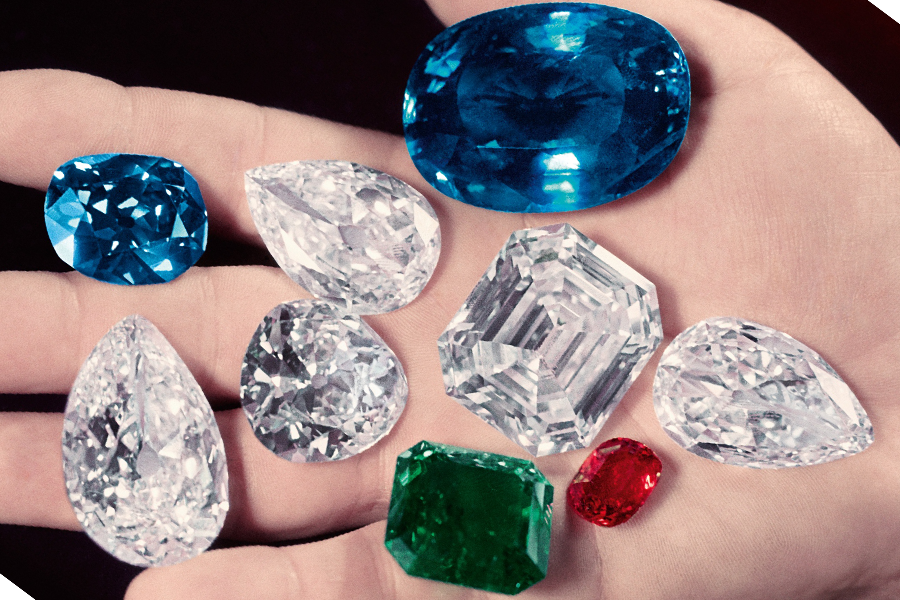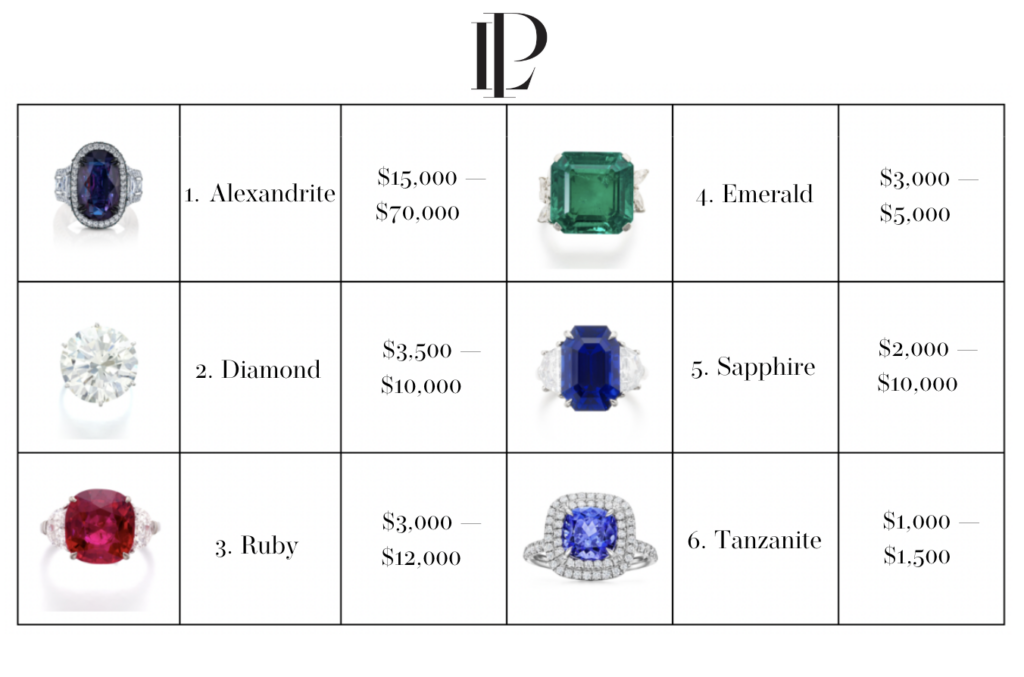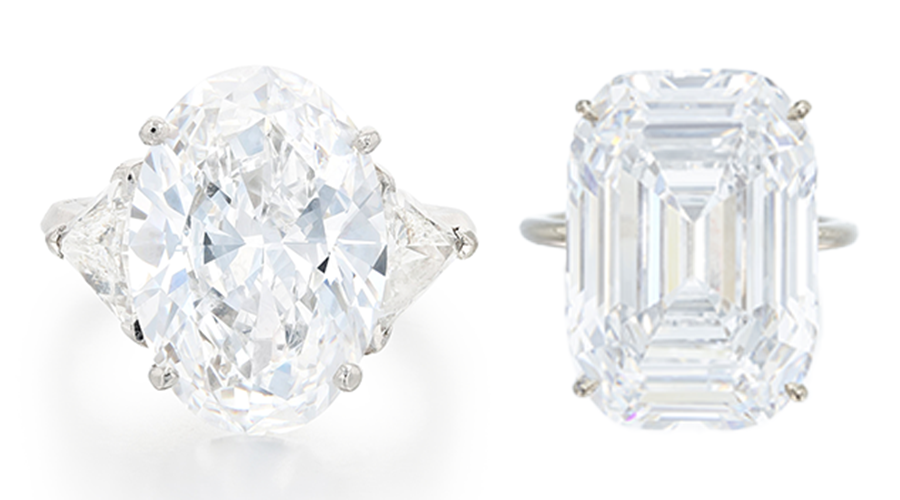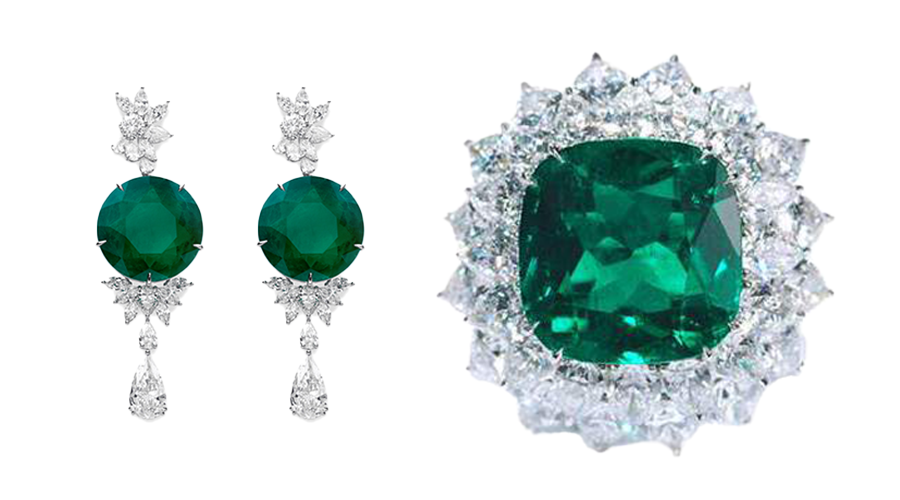The most expensive birthstones are incredibly rare and beautifully colored. Find out if your birthstone made the cut here.

Birthstones are gorgeous gemstones that correspond to a month in a year. Since the late 1800s, birthstone jewelry has been a sentimental gift for birthdays and wedding anniversaries. While every gemstone in the monthly birthstone chart is beautiful in its own way, some are more expensive than others because of their exceptional color, quality, and scarcity. Of course, prices vary dramatically depending on the quality. For example, the most exceptional examples can command over $1 million per carat. Our price ranges do not include these significant pieces but focus on typical birthstones you could encounter at a jeweler. Discover the most expensive birthstones so you can learn more about the factors contributing to their high value.
The 6 Most Expensive Birthstones in the World
Birthstone Price Chart

1. Alexandrite: $15,000 – $70,000 per carat

Many are surprised to learn that alexandrite is the most expensive birthstone, surpassing diamond. Alexandrite is one of June’s birthstones, along with pearl and moonstone. It is a variety of the mineral chrysoberyl. Alexandrite is one of the few gemstones that has color-changing properties. It naturally changes color from bluish-green in the daylight to purplish-red in incandescent light. Some jewelers refer to it as an emerald by day and a ruby by night. Miners first found this precious gemstone in 1830 in the Ural Mountains of Russia. Legend has it that this discovery occurred on the birthday of Czar Alexander II, then heir to the throne, so it was named after him. The gemstone’s red and green hues match Russia’s military colors, so it became the national stone of Russia.
Newly mined alexandrite is incredibly rare, so a lot of fine alexandrite is found in vintage jewelry. The original source of alexandrite closed after just a few decades of operation. In 1987, miners discovered a new deposit of alexandrite in Hematita, Brazil. While other smaller sources of alexandrite exist, Brazil has been considered the finest source of alexandrite since the 19th century. Because of its rare provenance, Russian alexandrite is more valuable than its Brazilian counterpart. However, Brazilian alexandrite is known for having better clarity and showing a more dramatic color change.
The value of alexandrite depends on the beauty and strength of its color-changing properties, which are a result of the complex way the mineral absorbs light. The more dramatic the color change, the more valuable the alexandrite is. What’s more, most alexandrite is found in small gemstones; fine-quality alexandrite over 1 carat is exceptionally rare and expensive. The price of alexandrite ranges from $15,000 per carat to between $50,000 and $70,000 per carat for high-quality gemstones over 1 carat.
2. Diamond: $3,500 – $10,000 per carat

The second most expensive birthstone is diamond, April’s birthstone. The most expensive colorless diamonds are large in size and have the highest rating of color (D through F) and clarity (Internally Flawless). Colorless diamonds that are D color, Internally Flawless, and Type IIa are the most covetable and, therefore, the most expensive. A D-color diamond has the highest degree of color clarity, which means it’s transparent even under intense magnification. An Internally Flawless diamond has no inclusions beneath its surface, and a Type IIa diamond is free of nitrogen and boron impurities. A high-quality diamond costs between $3,500 and $10,000 per carat. Beyond carat weight, color, and clarity, there are other factors that explain why diamonds are so expensive, such as diamond cuts and shapes.
While a colorless diamond is the most common gemstone for an engagement ring, fancy color diamonds are also popular. In fact, fancy color diamonds are more rare — and therefore more expensive — than colorless diamonds with the highest degree of color and clarity. Fancy color diamonds come in several colors, the rarest being red, green, purple, orange, pink, and blue. The Gemological Institute of America grades these diamonds on a scale based on the intensity of color. Fancy color diamonds with the highest color grades, Fancy Intense and Fancy Vivid, have more saturated hues and are therefore more rare and valuable.
Pink and blue diamonds are the most coveted because they’re larger than red diamonds, which are typically under a carat. Miners can only source these gemstones in a few mines, making them incredibly rare. In 2020, the Argyle diamond mine in Western Australia — the primary source of pink diamonds — closed because it couldn’t find enough diamonds to be profitable. That exacerbated the scarcity of pink diamonds, making them even rarer and more valuable as a result. The world’s most expensive diamond ring, the Pink Star, boasts a 59.60-carat oval-shaped fancy vivid pink Type IIa diamond. It is the world’s largest internally flawless fancy vivid pink diamond and fetched $71.2 million at a Sotheby’s auction in Hong Kong in April 2017.
3. Ruby: $3,000 – $12,000 per carat

The third most expensive birthstone is Ruby, July’s birthstone. Ruby is one of the Big Three, along with emerald and sapphire, a trio of the most precious colored gemstones. Rubies and sapphires are members of the corundum family, and the industry differentiates them by their color. Ruby famously has a red hue that ranges from dark orange-red to purplish red. In order to consider a gemstone a ruby, its dominant color must be red. If its dominant color is reddish-orange, then it’s an orange sapphire, and if it’s reddish-purple, then it’s a purple sapphire.
One of the most important sources of gorgeous rubies is the Mong Hsu region of Myanmar, previously named Burma. Burmese rubies are incredibly rare and high in value because of their deep red hue. In 2006, ruby production began in Mozambique in southeastern Africa; today, it’s one of the leading ruby sources. Other important ruby sources include Sri Lanka, Thailand, and Cambodia.
The color of a ruby significantly impacts its value. The most expensive ruby colors are red to slightly purplish red with medium to medium-dark tone and vivid saturation. Orangey or more purplish rubies are less valuable. Some rubies and sapphires are heat-treated, a practice that improves the overall appearance of a gemstone by enhancing the color and removing impurities. Unheated rubies are more expensive than heated rubies because they are far more rare and are truly natural marvels.
An untreated high-quality ruby typically costs around $3,000 per carat, whereas an untreated Burmese ruby of the same size can cost tens of thousands and even millions of dollars. In 2023, a 55.22-carat ruby called Estrela de Fura — the largest ruby ever found in Mozambique — fetched $34.8 million at a Sotheby’s auction in New York. Previously, the record holder was a 25.59-carat cushion-cut ruby from Burma, which sold for $30.3 million at a Sotheby’s auction in Geneva in 2015.
4. Emerald: $3,000 – $5,000

Emerald, May’s birthstone, is a variety of the beryl mineral species. The first known emeralds were mined in ancient Egypt. At the time, emeralds were exclusive to the royal and noble classes. Today, the main sources of emeralds are Colombia, Brazil, Zambia, and Zimbabwe. Most emeralds mined today originate from the Puerto Arturo mine in Colombia.
This colored gemstone tends to have jardins, or “gardens” in French, which refer to its natural inclusions. These inclusions resemble moss or plant foliage. It’s a common practice to fill these fissures with oils such as cedarwood and polymer resins to hide them and improve an emerald’s transparency. The most valuable emeralds are green to bluish-green with intense, vivid color saturation. An emerald is lower in value if it’s too dark, even if it is highly saturated. Colombian emeralds cost up to $100,000 per carat, whereas the price of a regular high-quality emerald ranges between $3,000 and $5,000 per carat. In 2023, Sotheby’s sold an 18.16-carat Columbian emerald that was enhanced by a minor amount of oil for $808,000.
5. Sapphire: $2,000 – $10,000 per carat

Sapphire is September’s birthstone. It comes in a range of colors, the most prominent and expensive variant being blue sapphire. Generally, the term “sapphire” alone refers to blue sapphire, whereas fancy color sapphire refers to its rainbow-hued counterparts. A famous source of sapphires is Kashmir Valley in northern India, surrounded by the ranges of the Himalayas. Kashmir produces the finest sapphires, which are incredibly valuable. They have an intense, medium-dark blue hue and a unique velvety appearance, often compared to the blue of cornflower, a type of flower. “In the gem trade, owning a Kashmir sapphire is a status symbol,” says Marco Hadjibay, creative director of Bayco Jewels, a high-jewelry brand that specializes in rare colored gemstones.
Another source for sapphires is Sri Lanka, formerly known as Ceylon. Ceylon sapphires are usually lighter and brighter than sapphires from other countries, such as Myanmar and Thailand. Today, the main sources for sapphires include Madagascar, eastern Africa, Sri Lanka, and Australia.
Sapphire is often heat-treated to improve color and sometimes clarity, although a heated sapphire isn’t necessarily less valuable than an untreated sapphire. Sapphire color ranges from very light to very dark violetish blue to greenish blue. The most expensive sapphire is velvety, violetish blue to blue in medium to medium-dark tones. Kashmir sapphires are very rare and can cost more than $200,000 per carat. The Jewel of Kashmir ring features a 27.68-carat emerald-cut sapphire of Kashmir origin. It sold in 2015 for $6.7 million at a Sotheby’s auction in Hong Kong, setting the record for the highest price per carat for a sapphire. The average cost of an unheated, high-quality sapphire is between $2,000 and $10,000 per carat.
6. Tanzanite: $1,000 – $1,500 per carat

Tanzanite is one of December’s birthstones, along with turquoise. It is a transparent variety of the mineral zoisite that becomes a beautiful blue or violet color with heat treatment. Miners discovered this gemstone in 1967 in the hills of Merelani in northern Tanzania. Even today, this is the only source of tanzanite on Earth. In 1968, Tiffany & Co. introduced this beautiful gemstone to the market and named it tanzanite after its country of origin.
This gemstone reflects different colors depending on the light, ranging from violetish blue to bluish violet. The deeper the color saturation, the more valuable a tanzanite is. Smaller tanzanites tend to be less saturated in color; the most expensive tanzanites weigh more than five carats. The quality of the cut also determines the value of tanzanite because it impacts the way it reflects colors. Tanzanites that show more blue than violet are the most covetable and expensive. On average, high-quality tanzanite costs up to $1,500 per carat. In March 2024, artist and jeweler Naomi Sarna broke the record for the largest cut tanzanite with her 703.4-carat discovery. She carved the extraordinary gemstone into a sculpture she named L’Heure Bleu, or “blue hour” in French.
